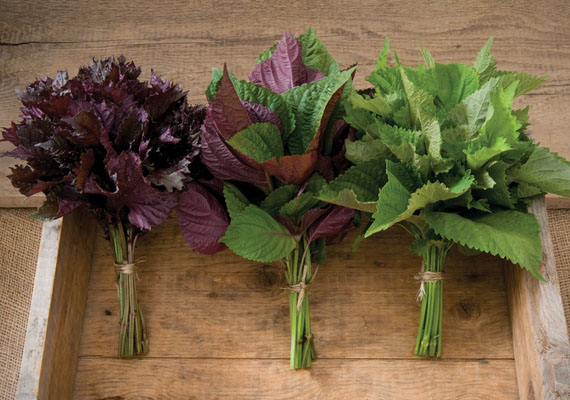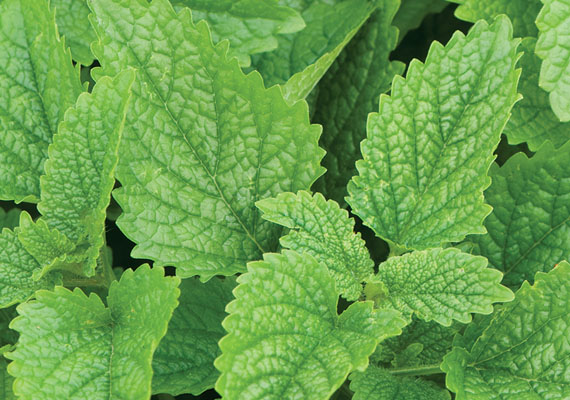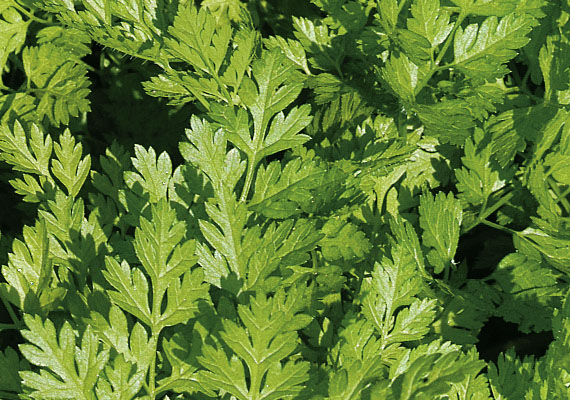- Succession-Planting Interval Chart for Herbs
- Growing Herbs in Containers | Tips for Production of Professional-Quality Container Herbs
- Herb Culture | Comparison Chart (PDF)
- Beyond Cilantro: Top 5 Culinary Herb Trends
- Mouthwatering Combinations: Culinary Herbs + Farm-Fresh Produce
- Destination Herb Farms: Hospitality Farming & Agritourism
- Growing Herb Plants for Direct-Market Sales
- Economic Outlook for Culinary Herbs
- Marketing Herb Plants | Building a Brand for Your Herb Business
- Overwintering Perennial Herbs
- Turning a Profit by Growing Herbs | The Useful Plants
Beyond Cilantro

Even though they can be difficult to find, these 5 culinary herbs are acquiring a following among innovative chefs and customers of ethnic and specialty food stores.
We encourage you to grow your own for a new culinary experience or to supply local specialty markets and restaurants in your area.
1 • Shiso ( Perilla frutescens )
As versatile as it is beautiful, shiso is commonly used in many types of Asian cuisine. Shiso is at its best when used fresh (not cooked) and given a place of visual prominence on the plate. There are several types of shiso: 'Red Shiso' is best known for coloring pickles and umeboshi. 'Green Shiso' is generally more tender, and is commonly served raw. 'Britton' is the most vigorous of the three and the most striking, with bicolored leaves that are green on top with red undersides. We also offer 'Asia Ip', a variant with flat, Britton-type leaves that are pink on the undersides.
In addition to its traditional uses as a culinary herb, shiso can be grown for use as a microgreen, cut-flower foliage, or a garden ornamental. Plants are highly productive, and easy to grow from seed to a full size or the micro green stage.
Flavor – Minty, basil-like; hints of cumin, clove, citrus.
Use – Leaves and flowers are both edible. Shiso is best used fresh, as the flavor is delicate and refreshing. Use whole leaves or slice thinly to flavor savory dishes and green salads, and to flavor and color pickles. Use as a garnish or an ingredient for maki, sushi, and spring rolls. Can also be grown as microgreen; we recommend 'Britton' for its vigor as well as good flavor.
Culinary pairings – Fish, shellfish, chicken, tofu, rice, noodles, cucumber, eggplant, pickles, teriyaki sauce, tamari, ginger, lemon, wasabi.
About – Native to Asia. Used in Japanese, Thai, Korean, and Chinese cuisines.
2 • Papalo ( Porophyllum ruderale )
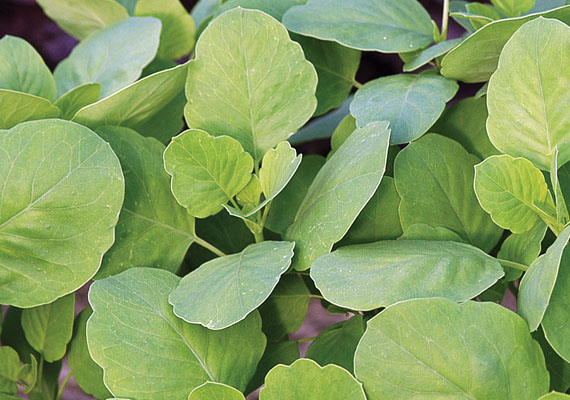
Papalo has a pungent flavor, and typically only a few leaves are needed to flavor a dish. If you're a lover of cilantro or arugula, you should try papalo.
The germination rate of papalo seed is naturally low, but otherwise it's very easy to grow and thrives during hot summer weather, when cilantro will tend to bolt or burn up in the heat.
Remember, a little goes a long way, so if you've never tried papalo start small and enjoy.
Flavor – Pungent arugula/cilantro-like, with hints of mint and citrus.
Use – Chop and use raw. Add to any dish well suited to cilantro: tacos, salsa, soups, guacamole, salads, chilies.
Culinary pairings – Beef, pork, seafood, cheese, rice, beans, avocado, chili peppers, tomatoes, tomatillos, cilantro, oregano, lemon, lime, garlic.
About – Grows wild in Mexico and South America, where it is commonly used. While still hard to find, papalo is becoming popular in the U.S. in specialty and ethnic markets.
3 • Epazote ( Dysphania ambrosioides )
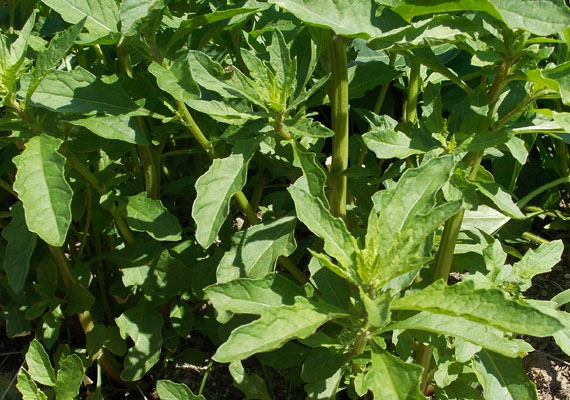
Epazote is used in traditional Mexican cuisine. It has a very strong flavor and should be used sparingly to flavor soups, beans, salads, and other savory dishes. The flavor is very distinct; though sometimes described as having a petroleum-like aroma, epazote combines beautifully with hardy foods such as beans, cheese, and eggs, and is well worth a try.
We no longer carry epazote seed, but it is very easy to grow and self-seeds readily. Snip flowering parts of the plant before they set seed if concerned about weed issues.
Flavor – Tarragon/cilantro-like, with hints of mint and citrus.
Culinary pairings – Beef, pork, eggs, cheese, rice, beans, avocado, potatoes, chili peppers, tomatoes, tomatillos, cilantro, lemon, lime, garlic.
Use – Add small amounts of fresh chopped leaves to flavor dishes after cooking or near the end of cooking time to preserve fresh flavor.
About – Native to Southern Mexico, Central America, and South America. Toxic if consumed in large amounts.
4 • Lemon Balm ( Melissa officinalis )
Lemon Balm, a member of the mint family, is similar to mint in many ways. Its leaves are tender, aromatic, and refreshing. Traditionally and most commonly used in tea and for its medicinal properties, lemon balm is increasingly appreciated as a trendy fresh culinary herb.
Tip: For a zesty twist on the mojito, use lemon balm in place of, or in addition to mint.
Lemon balm has a fondness for spreading around in the garden. Snip the flowering parts of this easy-to-grow perennial plant before they set seed, if concerned about weed issues.
Flavor – Lemon and mint.
Use – Savory dishes, soups, tabouli/tabbouleh salad, green salads, fruit salads, desserts, ices and ice cream, cookies and cakes, summer cocktails, tea (hot or cold), any recipe that calls for lemon zest and/or mint. Add moderate amounts of fresh chopped leaves to flavor dishes. Best if added after cooking or near the end of cooking time to preserve flavor.
Culinary pairings – Fish, seafood, chicken, noodles, rice, cream, fruit, aromatic herbs and vegetables, mint, ginger, garlic, honey.
About – Native to Europe and Mediterranean regions. Tolerates heat and drought.
5 • Chervil
Tender and mild, garden chervil is a lacy, parsley-like herb that is an ideal fresh addition to savory dishes and salads. Most commonly used in French cuisine, chervil is one of the main herbs included in traditional fines herbes, a staple of classic French cooking.
Chervil is relatively easy to grow but prefers cool, moist growing conditions. We've had very good success growing chervil in containers, where moisture levels can easily be monitored and the plants can be moved into a bit of shade on very hot days.
Flavor – Refreshing, mild anise/licorice, tarragon.
Culinary pairings – Poultry, fish, eggs, cheese, potatoes, tomatoes, asparagus, carrots, peas, butter, lemon, French tarragon, chives, garlic.
Use – Soups, salads, sauces, omelets, and other savory dishes. Leaves can be used at full maturity, or as a baby salad green or microgreen. Add small, freshly cut or chopped leaves to flavor dishes. Best if added after cooking or near the end of cooking time, to preserve the delicate flavor. Flowers are also edible and useful as flavorful garnish.
About – Native to the Caucasus but has spread through most of Europe, where it is now naturalized.


